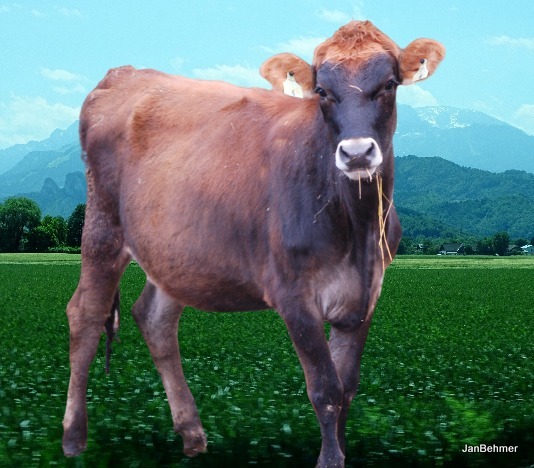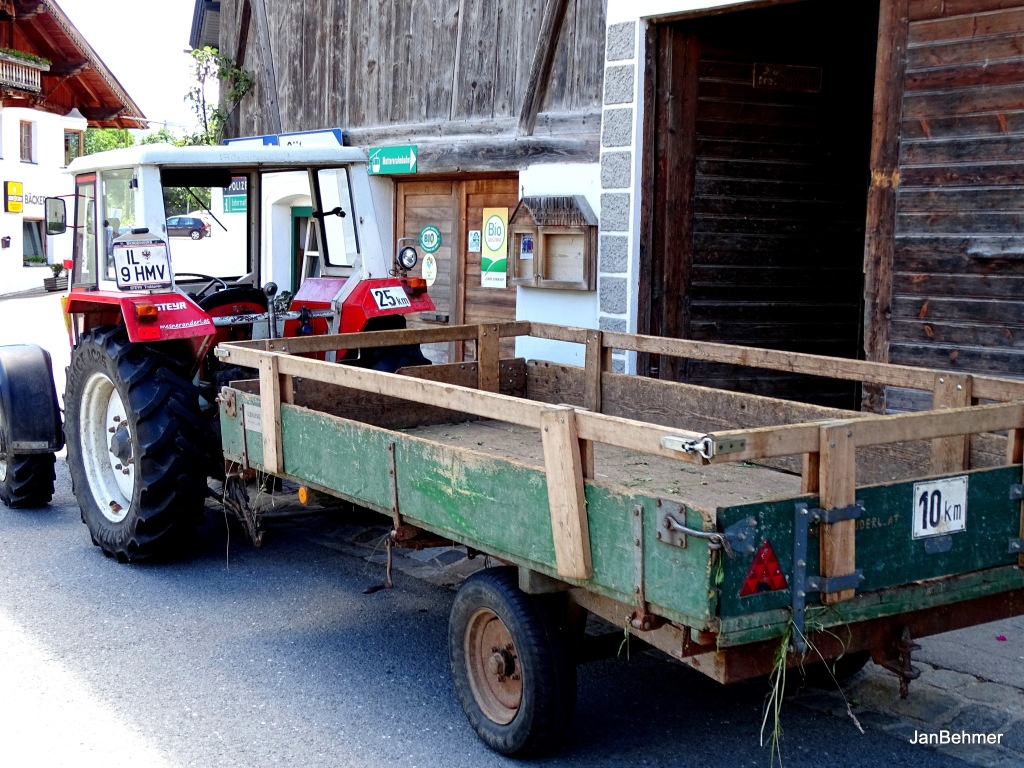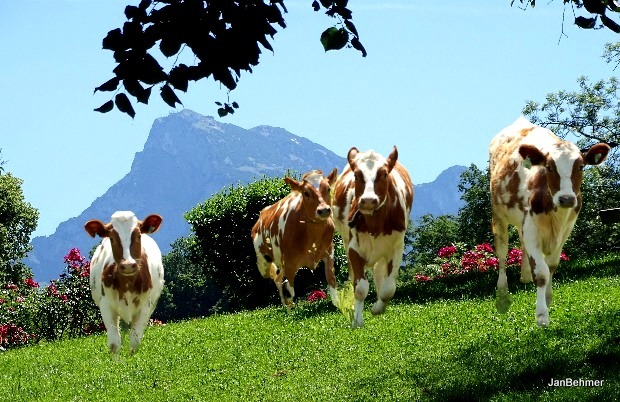Text by Steve VandeGriek Photos by Jan Behmer
Copyright 2020
The New York Times recently covered a news flash from postcard perfect Austria. Dairy cows in their Alpine summer pastures were attacking hikers trespassing through their domain. I suspect that the human source of this story was Twilight Zoned in Gary Larsen’s Far Side. I have context for this suspicion.
I’ve spent a certain share of my time with one foot in rural Vermont – long famous for being home to more dairy cows than people – and I’ve encountered my share of the bovine persona. I’ve seen cows mosey a bit faster than usual when it’s time to hit the barn to be relieved of the weight of twenty or so gallons of milk. I’ve witnessed a small herd of curious heifers shuffle up to a fence line to gaze at me as I walked by. They have on occasion even seemed to pose for a photo op. They were perhaps justifiably envious of my position outside the fence. But there was no snorting, stomping or charging involved. Even tail swatting at flies tends to be at best a half-hearted attack.
I’ve met dairy cows in Wisconsin and Pennsylvania, in Florida and Indiana, in England and Spain and France. And I’ve made the acquaintance of a few of their half million Austrian cousins. None of them vary very much in demeanor. They want only to graze. Cows are doe-eyed, gentle and shy. They are frankly too docile and too lazy to mount an attack on anything more threatening than grass. Cows are giant hopping-challenged rabbits.

What about the fighting bulls of Spain, you ask? True, they are aggressive, but they are trained to be so. And true, Vermont and Austrian bulls can be a bit more territorial than their female counterparts. So, a bored bull menacing an unwary intruder, maybe. But a ruthless gang of Elsie Bordens, their cowbells shattering the peace of the Alpine meadow, charging a lederhosen-clad hiker? Udderly ridiculous. Even the Brothers Grimm never concocted such fake news.
But the New York Times says it happened. The New York Times is not noted for fake news.
So, if true, were the hikers not clad in the familiar lederhosen? Did they yodel in accents that grated on Elsie’s ears? Or have Austria’s bovines appointed themselves virus vigilantes? Perhaps, in the even larger picture, the cows have anthropomorphized themselves and are following our lead.
Austria is a stunningly picturesque landscape. But topographically idyllic Austria is anthropologically not so tranquil. The Austrians are wary of the effects of excessive immigration on their cultural identity. Austria is a small country with a small population – about equal to that of New York City. Outside of metropolitan Vienna, which evinces subtle ethnic vestiges of the Austro-Hungarian Empire, Austria’s populace is largely – and accustomed to being so for generations – homogenous.
So it is in many smaller European countries. They are protective of their cultural heritage, and they view the current on-going flow of immigration as a threat. Many of these nations’ histories of cultural interference are so long ago absorbed that they’ve become inherent. The status quo balks at these new intercontinental challenges. The twentieth century Soviet surge into Eastern Europe, while piratic, did not pack the culturally disruptive punch of Iraquis in Slovakia. Europeans may empathize with the relentless stream of migrants escaping poverty and various degrees of genocide in myriad self-ravaging countries. They do not necessarily consider the stream to be their responsibility. Even wealthy Germany and knee-jerk liberal Sweden, who initially threw open their arms and doors, have now reversed their stance. And political and cultural objections aside, small countries like Greece and the Czech Republic and Croatia can’t afford, as the United States and China could, to harbor the onslaught.
China remained insular and isolationist for centuries. Ungrateful for being rescued from Japan in the twentieth century, it reverted to same and remains less than cordial toward being marginally more open today.
The United States’ much more recent evolution differentiates it statistically, but apparently not so much psychologically. Since more or less eliminating the pre-existing native culture, American’s brief history has hinged wholly on immigration from all corners of the planet. Diversity is our cultural identity. Yet, Americans in large numbers with short memories have an attitude about immigration not unlike the rest of the world. Before and during World War II, American isolationists stoked massive public opinion against admitting European Jewry trying to flee the Holocaust. Today seemingly half the nation wants to wall in our Southern border. And ostensibly but perhaps not entirely due to a pandemic, Americans are currently persona non grata almost everywhere. Take that, Yankee. I say “take that” because my keyboard won’t print the accent aigu over the “e” in touche.
Touche sounds apropos, but it isn’t. None of this is intrinsically simple tit for tat or right from wrong. It is emphatically the status quo.
Endemic racism – that current buzz phrase – isn’t just about anti-Semitism in France or Germany, or Black versus White in America. It isn’t relegated to Uighurs in China or Syrian gangs in Sweden. It seems to be the adamant global Zeitgeist. And the Zeitgeist never seems to change.
Conflict is what humans do, have always done and, all hope to the contrary, will apparently continue to do. There are certainly ever present attempts at altruism on which to desperately dote, but they never seem to outpoint the uber-aggressors. We are the neo-dinosaurs. Our collective and injudicious bellicosity thrives. It so absorbs us that we have now neglectfully and unwittingly ignored its impact on the arena in which we wage it – the planet itself. We spit on the air we breathe and the water we drink. The World Wildlife Fund experts estimate that in the past half century seventy per cent of the world’s wildlife has been wiped out by human activity.
The planet, though, is more than our equal. To paraphrase Kafka, when it’s man against the world, bet on the world. She doesn’t miss the dinosaurs. She doesn’t care if we annihilate each other. But when we all together threaten the planet’s well-being, she will defend herself against us. She will summon a meteor. She will send a virus. Or cows.

There is a cow in the tiny Tyrolean village of Mutters, Austria, housed in a barn-lette right on the village square. I forget her name but I recall her countenance. She was seemingly oblivious toward any nascent incursion from the surrounding bakery, church, and tractor repair shop.

As she was toward the foreign intruder. Me.
But you never know.




A fabulous article, bravo Steve and Janet. There are plenty of places on the web to see pretty travel photos and accounts of trips, but the true traveler gains wisdom and insight from every trip., and every new way to look at our world. I love the way this website is trending in this direction. Bravo! VOTE!!!!!!!